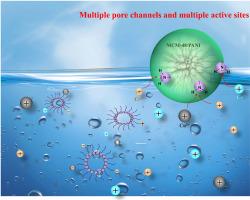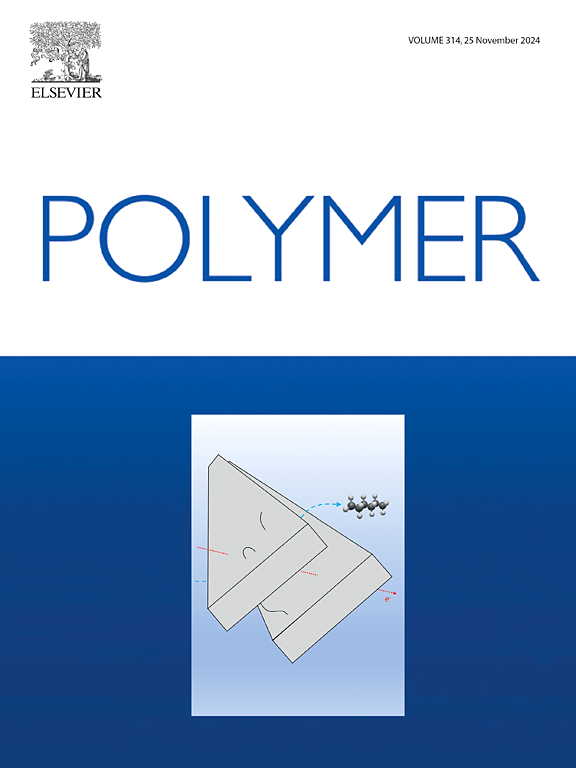Polyaniline modified fly ash based MCM-48 as a highly effective and raspberry-shaped adsorbent for Cd2+, Co2+, and Cu2+
IF 4.1
2区 化学
Q2 POLYMER SCIENCE
引用次数: 0
Abstract
With the aim of both reducing pollution and improving the utilization of coal by–products, a fly ash desilication solution is proposed as the silicon source for the preparation of the mesoporous molecular sieve MCM-48. A series of a highly effective and raspberry-shaped adsorbents for treating wastewater contaminated with heavy metal ions are obtained by modifying the MCM-48 with polyaniline (PANI) through a hydrothermal synthetic strategy. The results of experimental studies show that MCM-48/1PANI has removal efficiencies for Cd2+, Co2+, and Cu2+ of 97.67 %, 94.35 % and 87.26 %, respectively, which are significantly better than those of raw MCM-48. The adsorption behavior fits well with the proposed second-order kinetic equation and the Langmuir isothermal adsorption model. It is shown that the adsorbent shares electrons or electron transfer with the metal ions and forms a homogeneous monolayer adsorption on the adsorbent surface. In an experiment on adsorption of ions coexisting in solution, the selectivity of adsorption is found to be Cd2+ > Co2+ > Cu2+, with the differences being ascribed to the different hydration radii of metal ions. A test of cyclic regeneration performance shows that the MCM-48/1PANI adsorbent exhibits excellent stability after five cycles. Thus, this work provides not only a way for preparing MCM-48/PANI from fly ash, but also an efficient method for removal of heavy metal ions from wastewater.


聚苯胺改性粉煤灰基 MCM-48 作为 Cd2+、Co2+ 和 Cu2+ 的高效树莓形吸附剂
为了减少污染和提高煤炭副产品的利用率,提出了以粉煤灰脱硅溶液为硅源制备介孔分子筛 MCM-48。通过水热合成策略,用聚苯胺(PANI)对 MCM-48 进行改性,得到了一系列用于处理重金属离子污染废水的高效树莓形吸附剂。实验研究结果表明,MCM-48/1PANI 对 Cd2+、Co2+ 和 Cu2+ 的去除率分别为 97.67%、94.35% 和 87.26%,明显优于未加工的 MCM-48。吸附行为与提出的二阶动力学方程和 Langmuir 等温吸附模型十分吻合。实验表明,吸附剂与金属离子共享电子或进行电子转移,并在吸附剂表面形成均匀的单层吸附。在溶液中共存离子的吸附实验中,发现吸附选择性为 Cd2+ > Co2+ > Cu2+,差异归因于金属离子的水合半径不同。循环再生性能测试表明,MCM-48/1PANI 吸附剂在五个循环后表现出卓越的稳定性。因此,这项工作不仅提供了一种从粉煤灰中制备 MCM-48/PANI 的方法,还提供了一种去除废水中重金属离子的有效方法。
本文章由计算机程序翻译,如有差异,请以英文原文为准。
求助全文
约1分钟内获得全文
求助全文
来源期刊

Polymer
化学-高分子科学
CiteScore
7.90
自引率
8.70%
发文量
959
审稿时长
32 days
期刊介绍:
Polymer is an interdisciplinary journal dedicated to publishing innovative and significant advances in Polymer Physics, Chemistry and Technology. We welcome submissions on polymer hybrids, nanocomposites, characterisation and self-assembly. Polymer also publishes work on the technological application of polymers in energy and optoelectronics.
The main scope is covered but not limited to the following core areas:
Polymer Materials
Nanocomposites and hybrid nanomaterials
Polymer blends, films, fibres, networks and porous materials
Physical Characterization
Characterisation, modelling and simulation* of molecular and materials properties in bulk, solution, and thin films
Polymer Engineering
Advanced multiscale processing methods
Polymer Synthesis, Modification and Self-assembly
Including designer polymer architectures, mechanisms and kinetics, and supramolecular polymerization
Technological Applications
Polymers for energy generation and storage
Polymer membranes for separation technology
Polymers for opto- and microelectronics.
 求助内容:
求助内容: 应助结果提醒方式:
应助结果提醒方式:


